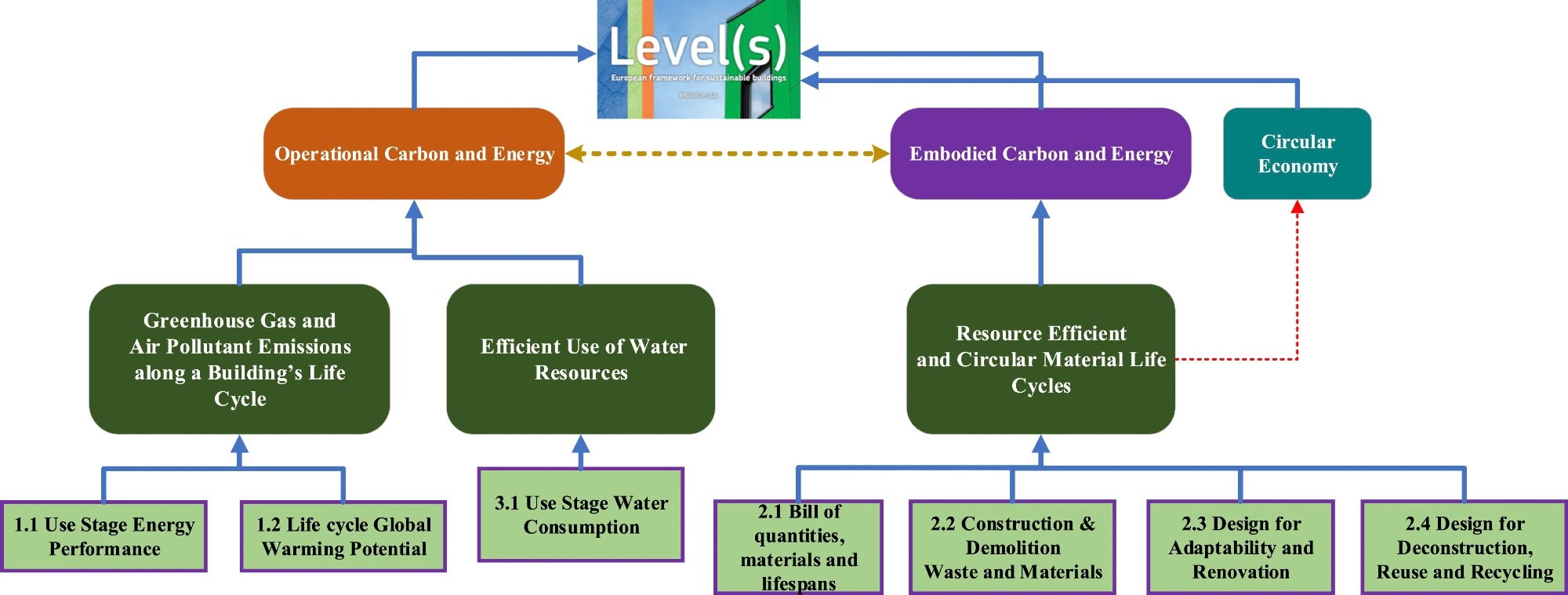In a recent study published in the journal Building and Environment, researchers critically analyzed the operational, embodied, and whole life cycle assessment (OEW) credits within various green building certification systems (GBCS) across different countries.
 Level(s) operational, embodied and whole life cycle assessment credits structure. Image Credit: https://www.sciencedirect.com/science/article/pii/S0360132324004116
Level(s) operational, embodied and whole life cycle assessment credits structure. Image Credit: https://www.sciencedirect.com/science/article/pii/S0360132324004116
They used several techniques to evaluate the technical manuals of these GBCS, identifying and comparing their strengths and weaknesses. Additionally, they proposed an improvement framework aimed at enhancing the effectiveness of GBCS in comprehensively capturing the environmental impacts of buildings throughout their life cycle.
Background
GBCS are voluntary frameworks that direct the design, construction, and operation of buildings toward sustainable and energy-efficient practices. They assess buildings based on various criteria, including energy and water use, materials, waste management, and indoor environmental quality (IEQ).
However, the criteria related to OEW credits within GBCS vary in comprehensiveness and consistency. These credits are crucial for evaluating the environmental performance of buildings throughout their lifecycle. Therefore, there is a need for a holistic and comparative analysis of OEW credits across different GBCS. Such an analysis would help identify gaps and opportunities for enhancing the effectiveness and consistency of these certification systems.
About the Research
In this paper, the authors selected eight GBCS from both developed and developing countries, as well as newly developed GBCS, for analysis. These GBCS included the leadership in Energy and environmental design (LEED) from the United States, Canada, and Spain; the Building Research Establishment Environmental Assessment Method (BREEAM) from the United Kingdom; Green Star NZ from New Zealand; the Building Sustainability Assessment Method (BSAM) from Malaysia; the Iranian Green Building Assessment Tool (IGBT) from Iran; the leadership in optimized urban sustainability (LOTUS) from Vietnam; the Level(s) framework from the European Commission; and GREENSL from Sri Lanka.
The researchers applied two methods to analyze the OEW credits in these GBCS: desktop analysis and document similarity. The desktop analysis involved a thorough review of the technical manuals of the GBCS, where they tabulated the OEW credits based on their weightage, scope, and requirements.
The document similarity method employed natural language processing (NLP) techniques, such as cosine similarity and term frequency-inverse document frequency (TF-IDF), to measure the similarity between the GBCS technical manuals based on their word contents. This dual approach allowed for a comprehensive evaluation of the OEW credits across different GBCS, identifying strengths and weaknesses and suggesting areas for improvement.
Research Findings
The outcomes showed significant variation in the OEW credits across the GBCS in terms of number, weight, scope, and methodology. The authors found that operational credits were prioritized more than embodied credits in most GBCS, and the concept of the circular economy was not widely embraced.
Additionally, waste-related credits were not given priority in many GBCS, and whole life cycle assessment credits were often optional or exemplary. The document similarity analysis revealed a range from 0.07 to 0.57, indicating that while there were some commonalities among the GBCS, there were also distinct features. Specifically, the LOTUS and BSAM GBCS had the lowest similarity compared to other GBCS, highlighting their unique approaches.
The study has several implications for the development and improvement of GBCS. It provides a comprehensive overview of the current state of OEW credits in GBCS and identifies the strengths and weaknesses of each system. The researchers provided important insights into the global relationships and patterns among the GBCS based on document similarity analysis.
Additionally, they introduced an improvement framework with six recommendations to enhance GBCS. These recommendations included increasing the weight and scope of embodied credits, incorporating circular economy principles and strategies, emphasizing waste reduction and diversion, making whole life cycle assessment mandatory and consistent, utilizing standardized methodologies for OEW credits, and regularly updating GBCS to reflect the latest developments and innovations in the field.
Conclusion
The paper summarized that OEW credits were critical aspects of GBCS but were not adequately and uniformly addressed in the existing systems. It provided guidance for the development and improvement of GBCS, especially regarding OEW credits, to ensure a full-fledged assessment of building environmental performance.
Enhancing awareness and understanding of OEW credits among stakeholders, such as building owners, designers, contractors, and occupants, was seen as a way to encourage the adoption of innovative solutions to reduce the environmental impacts of buildings.
Future work could extend the analysis to other GBCS and other dimensions of sustainability, such as social and economic aspects. Additionally, applying more advanced NLP techniques, such as topic modeling and sentiment analysis, was recommended to gain deeper insights into GBCS documents.
Journal reference:
- Olanrewaju, O, I., Enegbuma, W, I., Donn, M. Operational, embodied and whole life cycle assessment credits in green building certification systems: Desktop analysis and natural language processing approach. Building and Environment, 2024, 258, 111569. https://doi.org/10.1016/j.buildenv.2024.111569, https://www.sciencedirect.com/science/article/pii/S0360132324004116